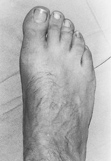یکشنبه ۰۲ مهر ۹۶ ۰۷:۴۲ ۱ بازديد
Overview
The accessory navicular is a congenital anomaly, meaning that you are born with the extra bone. As the skeleton completely matures, the navicular and the accessory navicular never completely grow, or fuse, into one solid bone. The two bones are joined by fibrous tissue or cartilage. Girls seem to be more likely to have an accessory navicular than boys.

Causes
Just having an accessory navicular bone Why is my Achilles tendon burning? not necessarily a bad thing. Not all people with these accessory bones have symptoms. Symptoms arise when the accessory navicular is overly large or when an injury disrupts the fibrous tissue between the navicular and the accessory navicular. A very large accessory navicular can cause a bump on the instep that rubs on your shoe causing pain.
Symptoms
Symptoms of this syndrome would include redness, swelling and tenderness over the navicular bone. The navicular bone is located on the inside of the foot approximately midway between the ankle bone and big toe joint. It will tend to be worse after activity and can be aggravated by those that wear very dressy shoes as opposed to casual shoes like sneakers. In other words, the flatter or less supportive the shoe, the greater the chance for pain.
Diagnosis
Diagnosis starts by speaking with the patient about symptoms. The physician will look at the foot and examine it for signs of an accessory navicular. By putting pressure on the area, the doctor may determine its presence simply by the presence of pain. The muscle, joint, and the overall structure of the foot may be considered, as well as the way in which the patient walks. If a diagnosis of accessory navicular syndrome is made, an X-ray or MRI may be ordered to confirm diagnosis.
Non Surgical Treatment
The initial treatment approach for accessory navicular is non-operative. An orthotic may be recommended or the patient may undergo a brief period of casting to rest the foot. For chronic pain, however, the orthopedic surgeon removes the extra bone, a relatively simple surgery with a brief rehabilitation period and a very good success rate.

Surgical Treatment
If conservative measures do not seem to help, however, you may need to have surgery to make adjustments to the bump. This could include reshaping the little bone, repairing damage to the posterior tibial tendon, or even removing the accessory navicular altogether.
The accessory navicular is a congenital anomaly, meaning that you are born with the extra bone. As the skeleton completely matures, the navicular and the accessory navicular never completely grow, or fuse, into one solid bone. The two bones are joined by fibrous tissue or cartilage. Girls seem to be more likely to have an accessory navicular than boys.

Causes
Just having an accessory navicular bone Why is my Achilles tendon burning? not necessarily a bad thing. Not all people with these accessory bones have symptoms. Symptoms arise when the accessory navicular is overly large or when an injury disrupts the fibrous tissue between the navicular and the accessory navicular. A very large accessory navicular can cause a bump on the instep that rubs on your shoe causing pain.
Symptoms
Symptoms of this syndrome would include redness, swelling and tenderness over the navicular bone. The navicular bone is located on the inside of the foot approximately midway between the ankle bone and big toe joint. It will tend to be worse after activity and can be aggravated by those that wear very dressy shoes as opposed to casual shoes like sneakers. In other words, the flatter or less supportive the shoe, the greater the chance for pain.
Diagnosis
Diagnosis starts by speaking with the patient about symptoms. The physician will look at the foot and examine it for signs of an accessory navicular. By putting pressure on the area, the doctor may determine its presence simply by the presence of pain. The muscle, joint, and the overall structure of the foot may be considered, as well as the way in which the patient walks. If a diagnosis of accessory navicular syndrome is made, an X-ray or MRI may be ordered to confirm diagnosis.
Non Surgical Treatment
The initial treatment approach for accessory navicular is non-operative. An orthotic may be recommended or the patient may undergo a brief period of casting to rest the foot. For chronic pain, however, the orthopedic surgeon removes the extra bone, a relatively simple surgery with a brief rehabilitation period and a very good success rate.

Surgical Treatment
If conservative measures do not seem to help, however, you may need to have surgery to make adjustments to the bump. This could include reshaping the little bone, repairing damage to the posterior tibial tendon, or even removing the accessory navicular altogether.